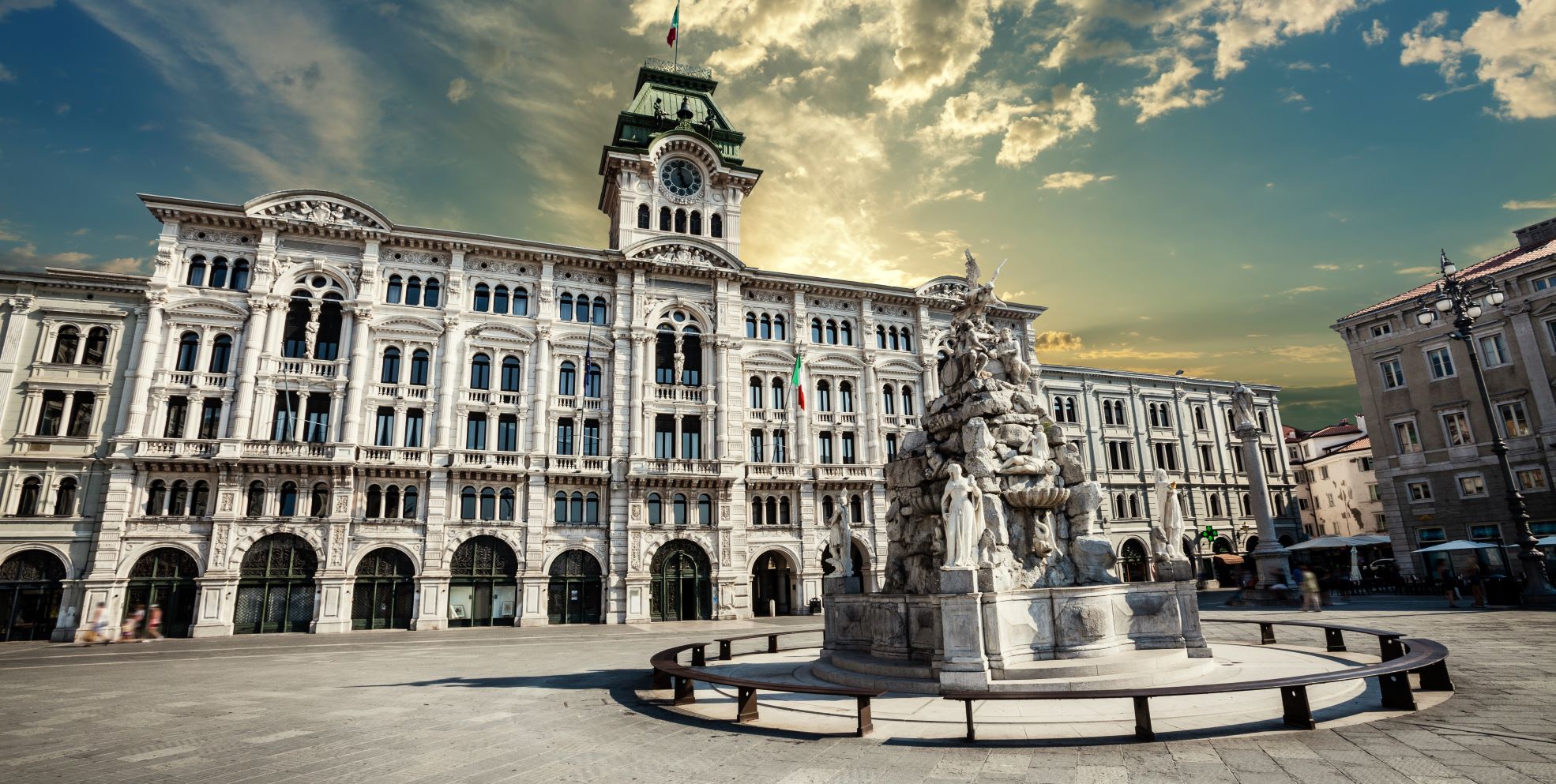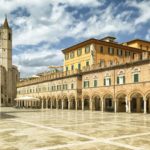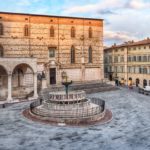Trieste, “Venice’s Little Sister”
In this article we will introduce you to a city that is quite different from the rest of mainland Italy, Trieste.
It is one of the largest cities within its beautiful region. Due to its proximity to other nations and regions, Trieste has been influenced over the years by various other cultures and civilizations, and is one of the richest economical places in Italy due to its extensive port and commercial shipping trade.
Where is Trieste and how to get there:
Trieste is Italy’s far north-eastern corner. Just two hours from Venice by car, close to the Slovenian border with several airports close by. If you’re visiting Venice, is easily accessible by train from Venice, with regular service, making it an enjoyable day trip if you’d like to explore a little further while you’re there. Trieste is often called “Venice’s Little Sister” because of all the sparkling canals. It’s the capital of the autonomous region of Friuli Venezia-Giulia, an area filled with open agricultural plains and cave-pocked limestone hills, crowned by the Italian Alps.
Let’s discover together what this beautiful city offers!
History of Trieste
City of Trieste wasn’t part of Italy until 1954. For four hundred years, Trieste was the port city of the Austro-Hungarian empire, and its Castello Miramare was built by the ill-fated Austrian Archduke Ferdinand Maximilian for his wife Charlotte between 1856 and 1860. Trieste’s architecture reflects this Austrian heritage and offers a completely different atmosphere than other Italian cities. Back in 178 BC the Romans founded a colony here called Tergeste.
Due to its favorable location on the sea it became a wealthy and powerful port almost immediately. After WW I and the disintegration of the Austro-Hungarian Empire, Trieste was assigned to Italy, along with large parts of Croatia and Slovenia. Then in WW II the region went over to Yugoslavia and in October of 1954 become part of Italy again, making Trieste the capital of the multicultural Friuli-Venezia Giulia region.
Today’s Trieste is a proud mix of cultures and architectural styles. You’ll see everything from Greek Orthodox churches to Jewish Temples and Catholic Cathedrals. The old families who have lived here for ages also show an interesting mix of Austro-Hungarian formality and Italian charm. In the beginning of the 20th century, Trieste was a cosmopolitan city frequented by artists such as James Joyce, Italo Svevo and Umberto Saba.
For lovers of history and architecture, Trieste is an instant history lesson.
A journey though Trieste
Start your journey from the heart of the city and from there explore the rest of it. The old town is centered around Piazza dell’Unità d’Italia, the largest public square in Europe that is open to the sea. With cafés and civic buildings on the other three sides, the Adriatic offers a dramatic backdrop to Trieste’s living room. It is the place where people meet and spend time together and it is its most iconic spot. Amazing during the day and incredibly romantic at night.
On a clear day, you can see the snow-capped Dolomites in the distance over the sea. If you’d like to know more about Dolomites and Veneto area, click here.
Just few steps from Piazza Unita’ d’Italia you can visit an amazing Italian theater, The Giuseppe Verdi Theater which was inspired by Teatro alla Scala in Milan, and just like Scala it was inaugurated with an opera by Salieri, Annibale in Capua. The theater Verdi is a master peace of Giannantonio Selva and Matteo Pertsch with the venue designed to be absolutely gorgeous: gliding, red velvet, elegant boxes, a frescoed ceiling worthy of the great international capitals and quite a new treat for the audience, the Italian and English surtitles. The theater has been the symbol of Trieste’s Italian cultural identity, spreading the knowledge of Italian musical culture in neighboring German and Slavic-speaking regions.
From there, just a few steps away, behind the Verdi Theatre rise remains of Roman Theatre, which was built between 1st and 2nd centuries AD. Take a moment to imagine a time when large audiences would come to enjoy events. Today you can experience the arena’s acoustics at summer concerts and theater productions. The Roman Theatre is free to visit. Arrive during daylight hours to be able to fully appreciate the architectural talents of the city’s former Roman rulers.
San Giusto Hill
Continue your visit up to San Giusto Hill to the Cathedral of San Giusto and Castello di San Giusto. There are more Roman ruins, and more incredible views, to be seen from the top of San Giusto Hill.
It’s the location of the oldest known settlement in the city. It’s also the location of the impressive San Giusto Castle, which was built around the time Trieste came under Austria’s control and protection. Visitors can admire the Late Gothic San Giorgio Chapel and Giuseppe Caprin’s sumptuous Sala Veneta. It also contains a rich collection of weapons dating from the twelfth century to the nineteenth. Fortunately, the castle never saw much military activity so survived pretty much intact.
The Roman ruins are outside the castle and make for an interesting contrast. San Giusto Cathedral sits atop the hill and the stunning views over the city and the Gulf of Trieste are breathtaking.
Find Canal Grande di Trieste in Borgo Teresiano, which is located about halfway between the city’s railway station and its main square, Piazza Unita’ d’Italia. There is no more memorable way to see Trieste’s beautiful squares, buildings and bridges than by traversing the waterway that cuts through the heart of the city. Whether you explore Canal Grande di Trieste by boat or on foot, there is no more unique way to discover the city. The waterway, which originates from the Gulf of Trieste, flows into the city center.
Main attractions
One of the attractions not to miss is absolutely the castle of Miramare we mentioned in the beginning of the article which was built as the residence of archduke Ferdinand Maximilian. Maximilian, who had moved to Trieste, was fascinated by the natural beauty of the area and decided to build a house. In a spectacular location on a rocky spur bumping out into the Gulf of Trieste, the Miramare Castle is no doubt one of Trieste’s major attractions.
Strongly influenced by Romanticism in its style, it is not exactly a castle, but rather a good example of a princely residence of the 19th century with magnificent rooms, and a large Italian- and English-style garden, with rare plants, small lakes and sculptures. Today, visitors can see the castle following a pre-established itinerary that takes them through several rooms still displaying the original furnishings, works of art, décor and precious objects dating to the mid-19th century, getting an idea of the life and tastes of the era. Maximilian ended up living in the castle only for a few years, in 1864, he moved to Mexico where he had been appointed emperor.
For the History lovers, Trieste hosts the only concentration camp in Italy. Civico Museo della Risiera di San Sabba served as a Nazi concentration camp during WW II, and today is a civic museum. You can have a tour in the structure to see the holding cells, and view historical objects.
Trieste offers also…
Combining Italian, Austrian and Slovenian influences, as a result, the cuisine of this region includes flavors and styles from many cultures. Friuli-Venezia Giulia has little productive land, allowing only a limited amount of livestock raising and agriculture.
San Daniele & Montasio
Alpine cattle produce the milk for cheeses such as Montasio, and pigs, preserved meat products such as the renowned San Daniele prosciutto. The mountain forests provide wonderful game and a variety of mushrooms, and mountain lakes supply lots of fresh trout.
Awarded wines
Friuli’s wine has made impressive strides over the past few decades. For centuries, Friuli has been a favorite destination of Austrian nobles, and noble variations of Chardonnay, Sauvignon Blanc, Riesling, Pinot Blanc and Pinot Grigio thrived here alongside an array of native grapes. The DOC Corso, known as a dry white and red wines, lies just beyond the borders of Trieste and keeps city restaurants stocked with its blends of Merlot, Cabernet Franc, Cabernet Sauvignon, Terrano and Refosco.
While you discover this beautiful region, book a tasting tour and enjoy the Carso (Karst) countryside with scenic walks through vineyards and olive groves and a wine-tasting day tour. Visit a beautiful wine cellar carved in the rock and taste exquisite cheeses, salami, olive oil and the famous Terrano wine, as well as other quality local delicacies produced in this scenic area surrounding Trieste.
Surrounding Trieste
Muggia
The village of Muggia is just 5km south of Trieste. It is a fishing village with a mini-marina and a picturesque old-town square dominated by a rather fine Venetian-Gothic church. Keep walking a further kilometer and you’ll reach the top of Monte Castellier (170m), where you’ll find a small archeological park with the ruins of the original Roman castrum dating to the 1st century BC. This lovely little town is also a great “getaway” for the much larger city of Trieste, which you can see across the water, but is on the same side of Adriatic coast as Muggia.
You could take advantage of this and rent a boat and admire the beautiful Golf of Trieste and an amazing port of the Adriatic Sea.
Grotta Gigante
The cave Grotta Gigante is one of the most fascinating sites in the Italian region of Friuli-Venezia Giulia. The floors and ceilings are covered with stalactites, stalagmites, and other natural compounds. The large main underground chamber is situated near Borgo Grotta Gigante. The cave, Grotta Gigante has a one hour-long guided tour, which is 500 steps up and 500 steps down, offering insight on the rare beauty of this magnificent cave.
Friuli Venezia Giulia, is home to the Guinness Book of World Records holder for the largest tourist cave on Earth.
Curiosity
Italy is known for a lot of things: pizza, pasta, the Colosseums, gelato, and Ferrari. But did you know Italy is also one of the countries that has the most caves on Earth? More than 35,000 in fact!
I hope that you enjoyed this insight into Trieste and that you get inspired to learn more or see for yourself! If you enjoyed this blog post, share it with a friend and if you are interested in learning more about traveling to this area or any other region in Italy, please contact us for more information.
Stay tuned for more blogs about other regions in Italy and be sure to click the link below for an example of tours we offer in Trieste area.





